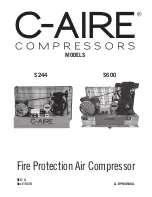
14
CAUTION: Synthetic lubrication hazard
If you will be using a synthetic lubricant, all downstream
piping material and system components must be
compatible.
Check and Fill Gasoline Tank
Check the gasoline level in the engine’s tank.
Fill tank outdoors with fresh unleaded gasoline
from a portable container.
Never pump fuel directly into engine at gas station.
Static charge can build and ignite fuel.
Use a UL approved fuel container to transfer gas to
the engine.
Always place container on ground to be filled. Keep
nozzle in contact with container while adding fuel.
WARNING: Fire/Explosion hazard
Gasoline is highly flammable and explosive. Heat,
sparks, and flames can ignite gasoline vapors, which
can become widespread during fueling. A flash fire
and/or explosion could result and cause serious injury
or death. Use extreme care when handling gasoline.
Carefully follow all the instructions in this section to
avoid the following conditions which could result in
gasoline ignition:
gas vapor collection inside enclosures
static electric sparks
sparks from electric wiring, batteries, or running
engines
sources of heat (such as a hot engine or exhaust)
open flames, including pilot lights
smoking
To Fill Gas Tank:
1.
Before removing fuel cap, make sure
compressor has been off and allowed to cool for
at least 2 minutes.
WARNING: Hot engine hazard
A running engine is hot enough to ignite fuel. Never add
fuel or remove gas cap if engine is running or still hot.
Let cool at least 2 minutes.
2. Remove fuel cap.
3. Add gas through the fill opening. Do not overfill.
Allow at least ½” of empty space below fill neck to
allow for gas expansion.
4. Replace fuel cap securely before starting engine.
5. Clean up fuel spills/splashes immediately.
If possible, move machine away from spilled
gas on the ground.
Wipe up spilled gas and wait 5 minutes for
excess gas to evaporate before starting
engine.
Gas-soaked rags are flammable and should
be disposed of properly.
If gas is spilled on your skin or clothes,
change clothes and wash skin immediately.
6. Store extra gas in a cool, dry place in a UL-
approved, tightly sealed container.
Inspect Fuel System/Check for Leaks
Inspect fuel system for leaks BEFORE starting
compressor. Look for:
Signs of leaks or deterioration
Chafed or spongy fuel hose
Loose connections
Loose or missing fuel hose clamps
Damaged gasoline tank
Selective gasoline shut-off valve
Do not start compressor until all needed repairs have
been completed.
Start-Up Procedures
CAUTION: Break-in period
Before initial use, open the ball valve and run the
compressor for 20 minutes to break-in pump parts.
1. Before Starting:
Drain storage tank and close drain valve
.
Close regulator.
2.
Turn the unloader to the engine START position.
(Figure 4)
Figure 4
Engine Start
Engine Run















































